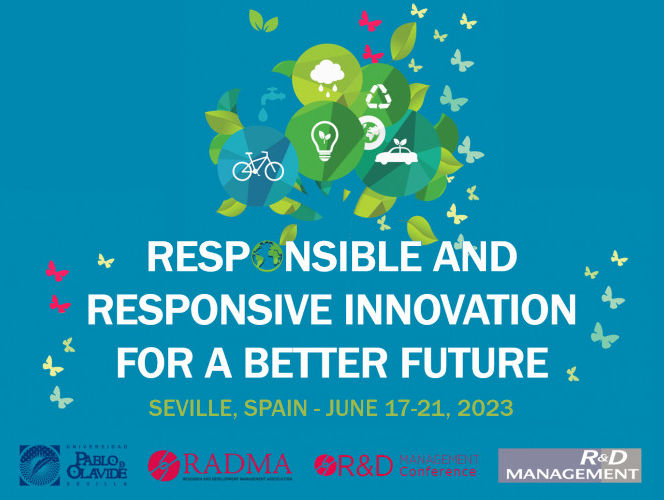The impact of Covid, conflict and constriction of supply routes has had a fundamental impact on small and medium-sized enterprises (SMEs), driving a move towards greater collaboration to improve sustainability, argue the co-chairs of a track in the 2023 R&D Management Conference, which is examining learning points from Open Innovation.
Alessia Zoppelletto, Pier Luigi Giardino, Erica Santini and Andrea Caputo (all from the University of Trento) comment that unexpected challenges have force European SMEs to rethink their business model towards a more sustainable one. To do so, due to their characteristics, SMEs have to open their organizational boundaries and find new collaborative strategies to face grand challenges.
Ahead of the conference we asked the co-chairs about the changes that they have observed.

Q. What is driving a change in strategy?
A. Over the last three years, European small- and medium-sized enterprises (SMEs) have faced unique challenges to the magnitude and contiguity of such events. The outbreak of the COVID-19 pandemic in early 2020 threw the European supply chain into a problematic situation, which then got worse because in March 2021 – for almost 60 days – the Suez Canal was unable to work correctly ($9 billion worth of goods passes through the 120-mile waterway each day); then last but not least, since February 2022, European SMEs have faced skyrocketing energy prices as well as turbulences for what concerns the supply of critical metals, wheat and fertilisers, due to the ongoing war in Ukraine.
Q. What impact is this having on business models?
A. The severity of such challenges forced European SMEs to rethink their business model towards a more sustainable one (i.e., integrating social, environmental, and economic considerations into corporates’ strategic decision-making to create long-term value for all stakeholders while promoting resilience and well-being for society, at large). To do so, due to their characteristics (e.g., the limited amount of financial and know-how resources), European SMEs are more prone to open their organisational boundaries and find new collaborative strategies needed to face such a convulsed business landscape.
Q. What do you think is the “secret ingredient” needed to be successful in the transition towards a sustainable business model?
A. This is a complex question since it depends on case to case. There are dozens of successful cases as well as of failures (we highly suggest readers watch Federico Frattini’s speech at TEDx Brianza, subtitles available also in the English language).
Nevertheless, if we have to pick only one ingredient that might determine the success or failure of the transition from an “old and closed” business model to a “new and open” one, we choose institutional power.
In our opinion, it is unquestionable the crucial role covered by institutional players (whether at local, regional, national or even international level) in supporting SMEs to accomplish fair and inclusive transitions towards a new business model, collaborating with peers as well as with larger firms.
As a virtuous example, we would report the case of “ART-ER Attractiveness Research Territory – Emilia Romagna”, a consortium born in the north of Italy aimed to promote R&D through participation in European and international networks and the development of collaborative projects, encouraging exchanges of knowledge, skills and experiences.
Another case can be represented by Circularity.com, which offers services and an ecosystem to support SMEs in re-designing a business model. It has been investigated in a recent article by Pizzi, Leopizzi and Caputo in the journal Management of Environmental Quality.
Q. Can you describe some interesting findings in this area?
A. We, as scholars, have recently marked the 20th anniversary since Henry Chesbrough conceptualised the idea of Open Innovation (OI), which is at the core of a fair and sustainable transition towards new business models – in light of European SMEs’ intrinsic characteristics.
However, scholars have found that such change via OI can be very challenging, particularly for companies that have relied on a closed model for a long time. One of the biggest challenges concerns managing intellectual property rights and ensuring that the company’s innovations and technologies are protected while allowing others to use and build upon them. Consequently, I agree with colleagues who call for future research to disentangle how companies may deal with this issue and what regulatory and legislative bodies should do to mediate positively.
Q. If someone was new to this topic what would you suggest they read to get a quick overview of the issues?
Federico Frattini (2020). “Open Innovation: Collaboration, ecosystems and “know-where”, TEDxBrianza. Available at: https://www.youtube.com/watch?v=BGD3OWGDTHU
Giardino, P.L., Cristofaro, M., and Marullo, C. (2023). Managing open innovation projects: An evidence-based framework for SMEs and large companies cooperation. Management Research Review, (ahead-of-print).
Marzi, G., Manesh, M.F., Caputo, A., Pellegrini, M.M., and Vlačić, B. (2023). Do or do not. Cognitive configurations affecting open innovation adoption in SMEs. Technovation, 119, 102585.
Pizzi, S., Leopizzi, R., & Caputo, A. (2022). The enablers in the relationship between entrepreneurial ecosystems and the circular economy: the case of circularity. com. Management of Environmental Quality: An International Journal, 33(1), 26-43.
Venturelli, A., Caputo, A., Pizzi, S., and Valenza, G. (2022). A dynamic framework for sustainable open innovation in the food industry. British Food Journal, 124(6), 1895-1911.
R&D Management Conference 2023: Responsible and Responsive Innovation for a Better Future
Pablo De Olavide University, Spain, 17-21 June 2023
Track Chairs: Alessia Zoppelletto, University of Trento
Pier Luigi Giardino, University of Trento
Erica Santini, University of Trento
Andrea Caputo, University of Trento


